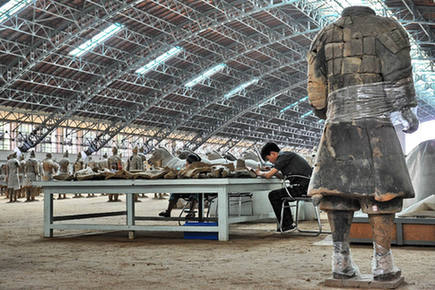| Uncovering the Colors of the Terracotta Army
By staff reporter LI WUZHOU
THE terracotta warriors and horses of Qinshihuang's mausoleum have been drawing the world's attention since they were first unearthed in 1974. Hailed by French President Jacques Chirac as "the eighth wonder of the world," they are also considered to be one of the most significant archaeological finds of the 20th century.
Qinshihuang became the first emperor of China in 221 BC when he founded the first unified state in Chinese history. Like most ancient rulers, the despot was obsessed with the construction of his final resting place. He put nearly 800,000 people to work on his enormous mausoleum; almost eight times more than those who were engaged in the construction of the Great Pyramid of Giza. The mausoleum covers an area of 56.25 square kilometers – 78 times the size of the Forbidden City. To date three underground pits have been discovered 1.5 kilometers east of the grave mound, filled with 8,000 life-size terracotta warriors and horses made to protect the emperor in the afterlife.
However, after being buried for more than 2,000 years, the terracotta army was badly damaged when discovered, and exposure to air caused further deterioration. Over the past few decades Chinese archeologists and scientists have been groping for methods and techniques to repair and protect these shattered clay figures. Collaborative research in the field has been launched between the Museum of the Terracotta Warriors and Horses of Qinshihuang and relevant institutions in countries such as Germany, UK and Belgium.
In the process of restoring 2,000-plus terracotta warriors and horses, as well as some bronze chariots, the museum of Qinshihuang's mausoleum has developed a raft of advanced techniques, including those to prevent mildew and retain colors. Its staff members have carried out dozens of research projects on cultural relic preservation and have drawn up seven standards and regulations in the realm, winning the museum two national science and technology awards.
 |
|
Chinese archeologists and scientists have been groping for methods and techniques to repair and protect the terracotta army. |
Reconstructing the Bronze Chariots
During the 2010 Shanghai World Expo, a 2,200-year-old bronze chariot was displayed in the China Pavilion. The work, known as No.1 Qin Mausoleum Bronze Chariot, is lauded as the crown of bronze wares. The two-wheeled vehicle supposed to be drawn by four horses is painted with elegant patterns, decorated with more than 1,000 glittering gold and silver ornaments and carries a complete set of leather harnesses. The bronze is a copy of real chariot down to the tiniest details, including the 30 spokes on the bronze wheels that spread force from the chariot's immense weight along the wheel rims. It is one of the two chariots unearthed near Qinshihuang's mausoleum in 1980 that are believed to be replicas of the personal carriage of the emperor.
On their discovery, the two chariots were in more than 3,000 fragments, rusted and bent out of shape. After intense study of the materials and shapes of these shreds that were scattered in disorder, archeologists worked out the structure of the vehicle and relative positions of the shreds. To piece these bronze fragments together, scientists conducted a series of simulation experiments to select the most effective and minimally invasive techniques, combining bonding and welding with mechanical methods. Eventually the two chariots were successfully restored.
| 